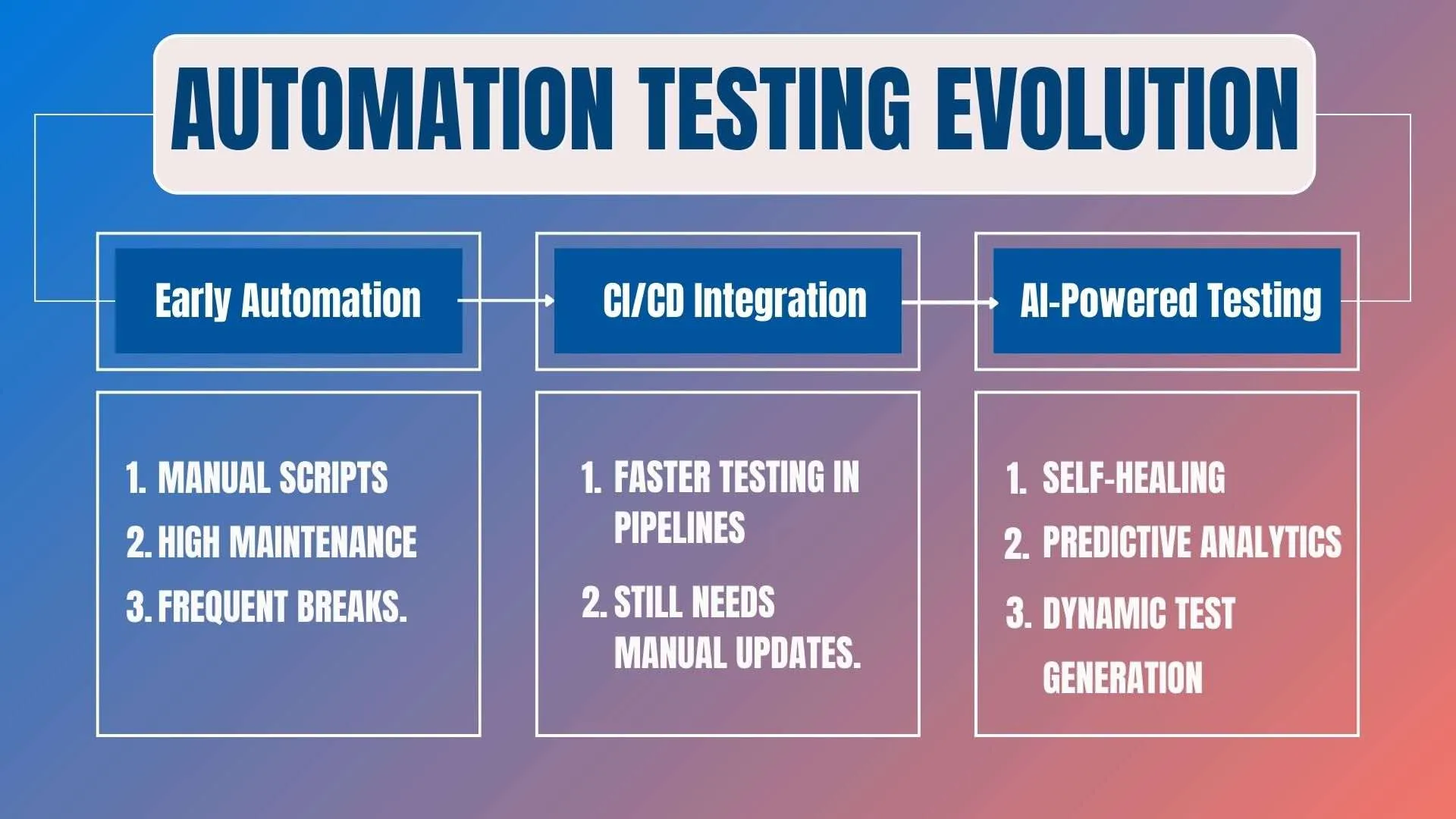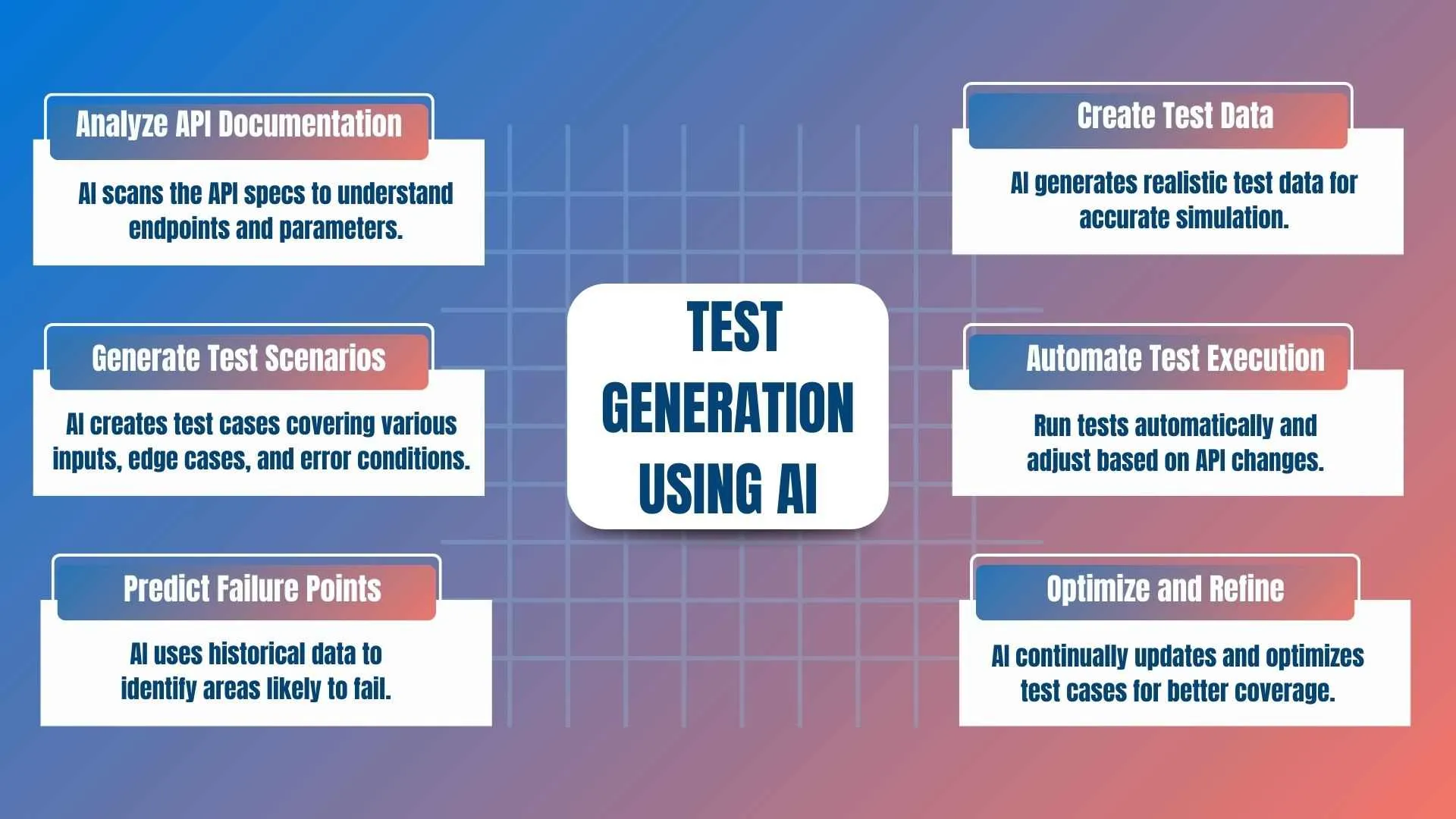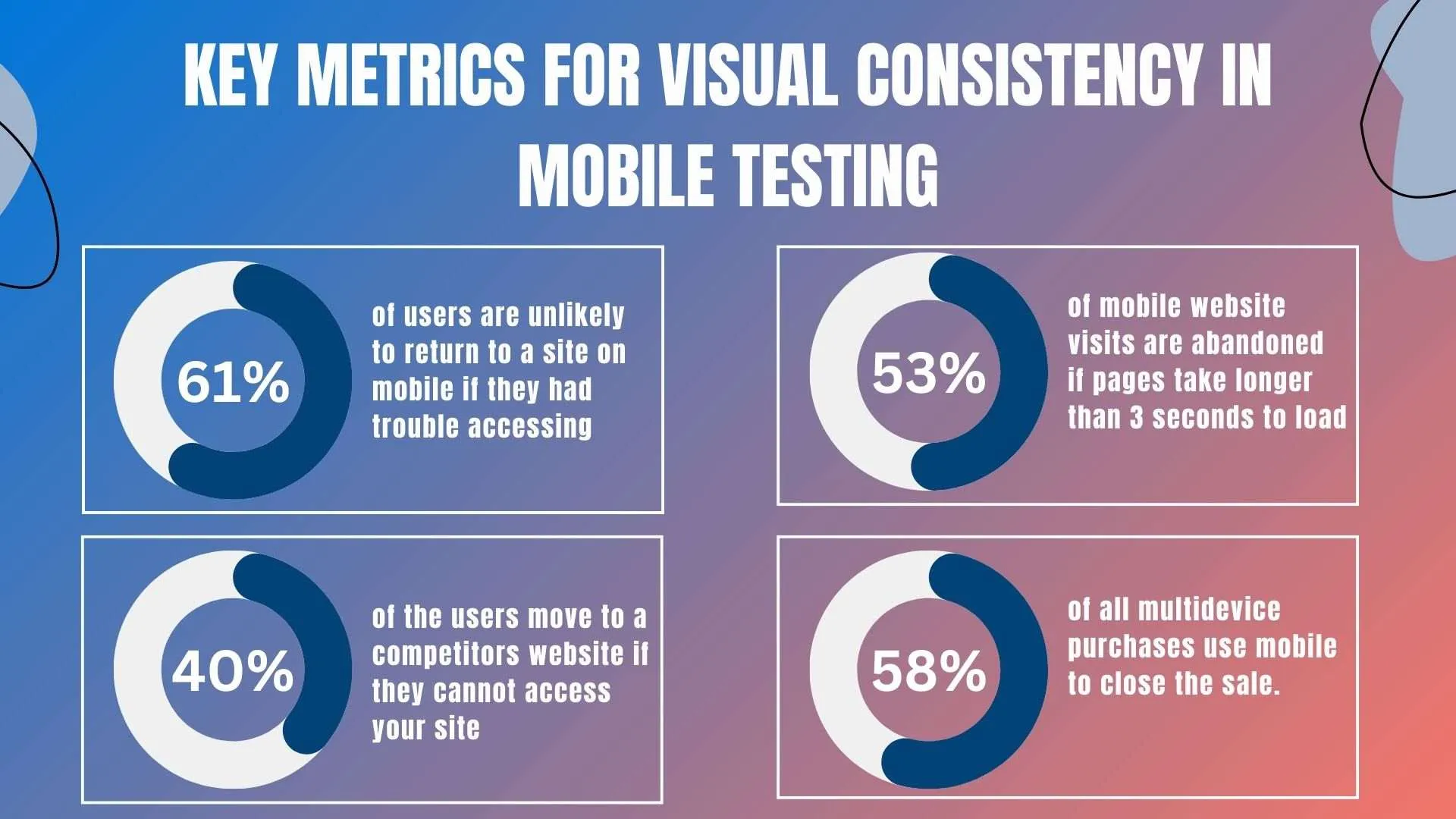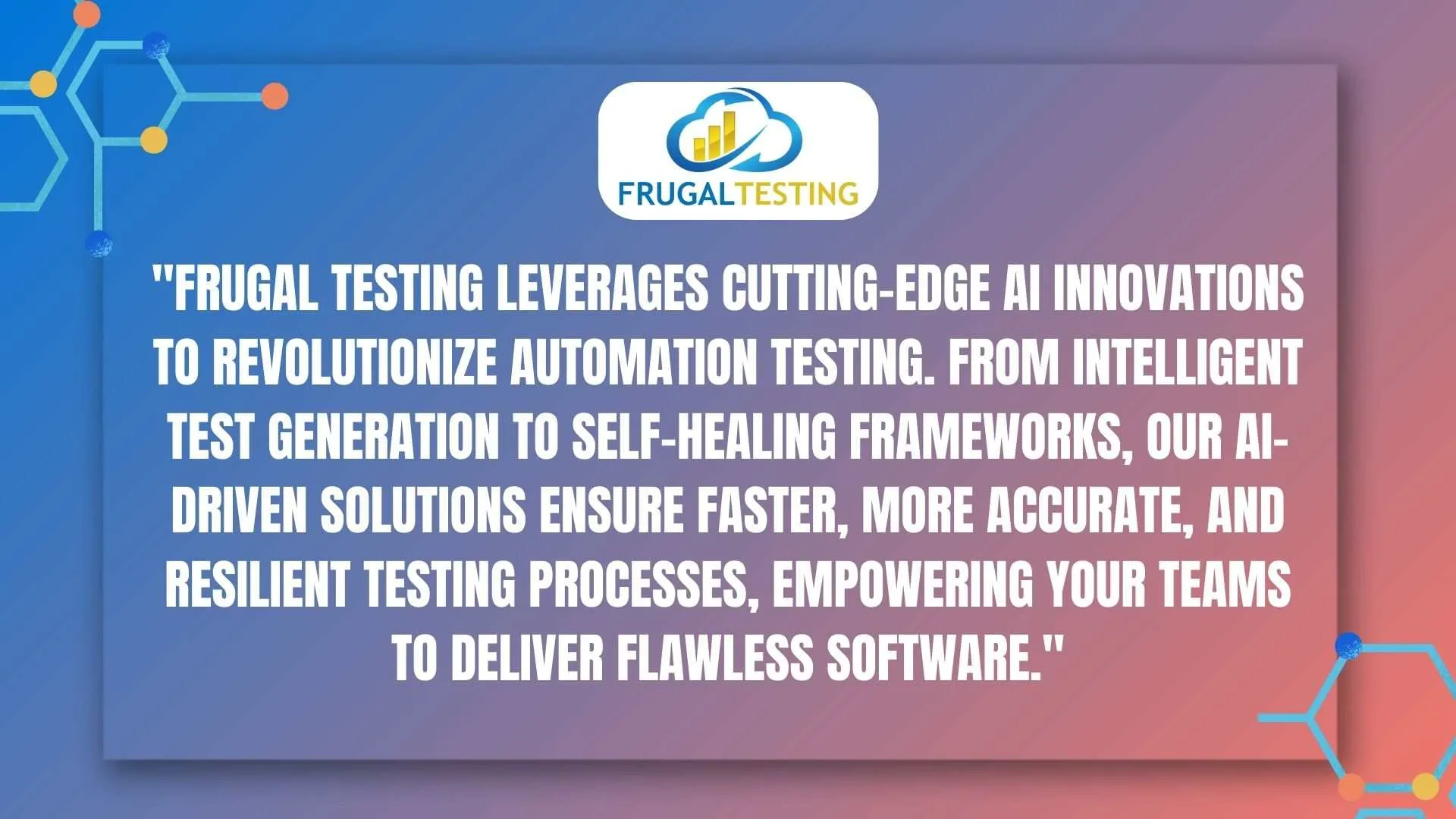Automation testing has come a long way, moving from manual, time-consuming processes to faster, automated scripts. But in today’s fast-paced software testing world, even automation isn’t enough. 🏃♂️ This is where Artificial Intelligence (AI) steps in, transforming how we approach testing. 🧠 AI takes testing beyond the basics, enabling smarter, more efficient, and predictive test processes. From intelligent test case generation to self-healing frameworks, AI is revolutionizing how we approach software quality. Let’s explore how AI is transforming automation testing for good! 🔍✨
🏆 The Top 5 AI-Powered Automation Testing Innovations
- AI for Intelligent Test Case Generation 📝
- AI-Powered Predictive Analytics for Test Prioritization 🔍
- Self-Healing Automation Frameworks for Enhanced Test Resilience 🛡️
- AI-Powered Defect Detection and Reporting Tools 🐛
- Natural Language Processing for Simplified Test Automation 💬
The Evolution of Automation Testing
Automation testing has undergone several phases of transformation, adapting to the rapid advancements in software development. These key milestones outline how testing has evolved:
- Initial Phase 🖥️:
- Early Tools: Automation began with automation testing tools like Selenium, which automated browser actions but required substantial manual script writing.
- Heavy Script Maintenance: Scripts needed constant updates as UI elements changed, making test maintenance labor-intensive and prone to errors.
- Limited Flexibility: Test scripts were rigid, often breaking when the UI or functionality underwent minor updates.
- Introduction of CI/CD 🚀:
- Integration with Development: Automation testing became an integral part of CI/CD pipelines, enabling continuous testing alongside development to ensure code quality.
- Faster Feedback Loops: This approach significantly reduced testing time by automating frequent testing in software development lifecycles.
- Ongoing Manual Intervention: Despite the improved speed, automation scripts still required regular maintenance and updates as the codebase evolved.
- AI-Driven Transformation 🤖:
- Self-Healing Scripts: AI introduced self-healing automation, where test scripts autonomously adjust to changes in UI elements without manual intervention.
- Predictive Analytics: AI analyzes historical data and recent changes to predict failure points, allowing for risk-based test prioritization.
- Intelligent Test Generation: AI uses real-time application behavior and user data to dynamically generate and update test cases, ensuring broader and more relevant test coverage.
This progression has not only enhanced the accuracy and speed of testing but also minimized human errors, allowing teams to focus on higher-level issues and maintain software quality in fast-paced environments.

How AI Transforms Automation Testing
Artificial intelligence (AI) has significantly elevated the efficiency and scope of automation testing. By leveraging machine learning algorithms and intelligent systems, AI optimizes testing workflows, enhances defect detection, and accelerates release cycles, helping teams to deliver higher-quality software products. Let’s dive into how AI is reshaping various aspects of automation testing.

1. AI for Intelligent Test Case Generation📊
AI is transforming test case generation by using real-time user data, historical testing trends, and application behavior to create precise and relevant test cases. It automates what was traditionally a time-consuming and manual process.
How AI works here:
- Behavioral Analysis:
- AI analyzes real-time user interactions, identifying critical journeys and high-risk areas requiring focused testing.
- Practical Example:
- Fraud Detection in Banking - AI models identify deviations from normal behavior (e.g., purchases made in unusual locations or patterns) and flag potential fraud for further investigation.
- Historical Data Learning:
- AI leverages past test data to identify error-prone components, prioritize frequently defective areas, and highlight previously neglected sections.
- Practical Example:
- Predictive Maintenance in Manufacturing - Machine learning models analyze vast amounts of historical data to understand the conditions leading up to a failure, allowing manufacturers to schedule maintenance and reduce downtime.
- Dynamic Test Generation:
- AI predicts problem areas after code changes, adjusting test cases dynamically based on historical data and risk levels.
- Practical Example:
- For instance, if a developer updates the payment processing function of an e-commerce app, AI generates tests to validate payment workflows, ensuring no regressions or bugs have been introduced.
Benefits:
- Increased Efficiency: Test case creation is automated, reducing human intervention.
- Enhanced Test Coverage: AI ensures that no critical scenario is overlooked.
Adaptability: Test cases evolve with the application, guaranteeing relevance at all times.

2. AI-Powered Predictive Analytics for Test Prioritization🔍
Testing everything in a short release cycle can be inefficient. AI uses predictive analytics to prioritize testing tasks based on the likelihood of failure, the impact of code changes, and associated risks.
How AI works here:
- Risk-Based Prioritization:
- AI evaluates code changes and focuses testing on high-risk areas based on historical data and the scope of updates.
- Practical Example:
- Financial Trading Platform - AI evaluates recent trading algorithm updates and identifies risk calculation module changes. Based on the scope of these changes and historical bugs in that area, it prioritizes tests for the risk calculation engine, ensuring critical functions are thoroughly tested before release.
- Failure Prediction Models:
- AI predicts likely failure points using machine learning, based on historical data and recent code changes.
- Practical Example:
- Autonomous Vehicle Software - AI uses machine learning to analyze past failures in sensor integration and recent changes to navigation algorithms. By predicting that the sensor data processing component is most likely to fail under certain conditions, it focuses testing on that module to prevent critical failures in real-world driving scenarios.
- Test Case Optimization:
- AI streamlines test suites by removing redundant test cases and prioritizing essential ones for maximum efficiency.
- Practical Example:
- E-commerce Checkout Process - AI reviews thousands of test cases for an e-commerce platform's checkout flow, identifying redundant tests for similar payment methods. It eliminates unnecessary tests while ensuring that key scenarios, such as coupon application and payment gateway integration, remain covered, reducing the overall test execution time.
Benefits:
- Time Savings: Testing time is reduced by focusing only on the areas most likely to introduce bugs.
- Risk Reduction: High-risk areas are prioritized, ensuring critical issues are caught early.
- Continuous Improvement: AI learns from each release cycle, improving prioritization accuracy over time.

3. Self-Healing Automation Frameworks for Enhanced Test Resilience🛠️
One of the most significant innovations AI brings to automation testing services is self-healing frameworks. These frameworks adapt to changes in the application, such as shifts in the UI, reducing the need for manual intervention when maintaining test scripts.
How AI works here:
- Element Identification:
- AI detects UI component changes and automatically updates test scripts to match the new layout, preventing test failures.
- Practical Example: some text
- Retail Mobile App – During a UI update, the "Add to Cart" button’s ID is changed. Instead of test failures, AI automatically identifies the updated button by analyzing its new properties, ensuring the test script seamlessly interacts with the modified interface.
- Script Adaptation:
- AI autonomously adjusts automation scripts when UI changes occur, keeping tests functional without manual intervention.
- Practical Example: some text
- Banking Web Application - After a layout update where the login page is redesigned, AI detects the changes in element positioning and updates the automation scripts for login functionality in real time, preventing disruption to ongoing tests.
- Error Prediction :
- AI predicts potential automation script failures by analyzing past test failures and upcoming changes.
- Practical Example: some text
- Video Streaming Service - AI analyzes past test failures related to buffering issues under high user load. It predicts that an upcoming code change in the video encoding algorithm is likely to cause similar issues, prompting testers to focus on load testing for video playback.
Benefits:
- Reduced Maintenance Effort: Self-healing capabilities drastically reduce the time spent on script maintenance.
- Increased Reliability: Automation frameworks remain functional even when minor changes are introduced.
- Scalability: As applications grow, the self-healing framework scales effortlessly without requiring significant manual oversight.

4. AI-Powered Defect Detection and Reporting Tools🧑🔧
AI enhances defect detection by scanning logs, code, and runtime data to identify potential issues faster than manual testing methods. AI-powered tools go beyond simply identifying defects; they also help diagnose and suggest resolutions.
How AI works here:
- Anomaly Detection:
- AI monitors application logs for deviations from normal behavior, triggering alerts when anomalies suggest potential defects.
- Practical Example:
- Online Banking App - AI monitors transaction logs and detects unusual spikes in transaction times during fund transfers. This anomaly suggests a performance bottleneck, and the system triggers an alert to investigate the potential cause before it impacts more users.
- Pattern Recognition:
- AI identifies recurring patterns in defects, categorizing them to prioritize fixes and catch subtler issues.
- Practical Example:
- Healthcare Management System - AI identifies a recurring pattern of data entry errors when healthcare providers input patient vitals. It groups these defects and recognizes that they often happen in specific data fields, enabling the team to focus on improving the data validation logic.
- Root Cause Analysis:
- AI pinpoints the root cause of defects by analyzing logs and code, sometimes suggesting fixes based on past patterns.
- Practical Example:
- E-commerce Website - After a shopping cart failure, AI analyzes error logs and traces the issue back to a recent update in the discount calculation module. It highlights the specific lines of code likely causing the issue, reducing debugging time and suggesting rollback as a quick fix based on similar past defects.
Benefits:
- Faster Defect Identification: AI tools work in real-time, catching defects earlier in the development cycle.
- Improved Accuracy: AI eliminates the possibility of missing subtle defects, improving overall testing quality.
- Detailed Reporting: Automated reporting with suggested fixes ensures that issues are not only identified but also resolved more efficiently.

5. Natural Language Processing (NLP) for Simplified Test Automation✍️
Natural language processing (NLP) brings a new level of accessibility to test automation. It enables non-technical team members to contribute to testing by translating plain language into executable test scripts. This allows a broader range of people to participate in automation efforts, reducing the bottleneck traditionally created by script writing.
How AI works here:
- Plain English to Code:
- NLP converts natural language test scenarios into executable automation scripts, allowing non-technical users to write test cases.
- Practical Example:
- Travel Booking Platform - A product manager writes "Verify that users can book a round-trip flight from New York to London." AI-powered NLP converts this plain English scenario into an automation script that tests the flight booking functionality, eliminating the need for coding expertise.
- Test Case Simplification :
- NLP automatically generates test cases from simple instructions, reducing the need for manual scripting and improving efficiency.
- Practical Example:
- Food Delivery App - A tester provides a simple instruction like “Check if the user can apply a promo code.” NLP interprets this and automatically generates a detailed test case, including steps for logging in, adding items to the cart, applying the code, and validating the discount, speeding up the test creation process.

- Collaborative Testing :
- NLP enables non-technical team members, such as product managers, to create test cases.
- Cross-functional teams can contribute to the automation process without needing to write code.
- This enhances collaboration across departments, making test automation a more inclusive process.
Benefits:
- Wider Participation: Non-technical stakeholders can now contribute to test creation, reducing the burden on QA teams.
- Faster Test Creation: Plain-language input speeds up the test creation process significantly.
- Error Reduction: By simplifying the test creation process, NLP minimizes the risk of errors introduced by manually written scripts.
AI’s Utility in API Automation Testing
AI is revolutionizing API testing by automating complex tasks and enhancing overall testing efficiency. It brings more precision and agility to the process, making API tests more reliable and easier to manage.
Streamlining API Test Generation Using AI

- Automatic API Test Creation 🤖
- AI analyzes API documentation and traffic patterns to generate relevant tests.
- Reduces manual effort and accelerates the creation of test cases.
- Ensures comprehensive coverage by identifying edge cases and corner scenarios.
- Natural Language Processing (NLP) 🗣️
- Converts API requirements into test cases using NLP.
- Simplifies complex API testing processes.
- Enables non-technical users to create tests by describing functionalities in plain language.
- Adaptive Test Scripts 🔄
- AI-driven tools can adapt to API updates.
- Keep test scripts relevant as the API evolves.
- Minimizes test maintenance by automating script changes.
- Automated Test Data Generation 📊
- AI can generate realistic data sets, ensuring accurate simulation of real-world API usage.
- Improves test relevance by mimicking real interactions with APIs.

Efficient API Defect Identification with AI Tools
- AI-Based Defect Detection 🔍
- AI analyzes API responses to detect anomalies or defects more effectively.
- Reduces false positives by learning from historical test data.
- Enhances defect accuracy by understanding the patterns in API behavior.
- Predictive Analytics for Root Cause Analysis 🔧
- AI identifies the root cause of API defects faster.
- Uses data mining techniques to predict likely failure points.
- Suggests targeted fixes based on past defect history and severity.
- Proactive Monitoring of API Performance 🚀
- AI continuously monitors API response times and throughput.
- Alerts teams about potential performance issues before they impact the end users.
- Automated Failure Prioritization 📈
- AI-driven testing tools rank failures based on their impact.
- Helps prioritize critical defects, ensuring the most significant issues are resolved first.
- Saves time by focusing on high-risk areas instead of blanket testing.

These AI-driven approaches to API automation testing greatly improve test coverage, efficiency, and accuracy, making them essential in modern software development.
AI for UI Automation Testing
The integration of AI into UI automation testing reshapes the way testing is performed, offering enhanced accuracy, adaptability, and scalability. By automating repetitive tasks and analyzing user interactions, AI allows testers to focus on critical issues while improving testing coverage across different platforms. Here's a detailed look into how AI is driving advancements in UI automation testing:
Enhancing Mobile App Testing with AI
AI's role in mobile application testing goes beyond just automation; it provides intelligent insights and adaptability that help deliver high-quality applications quickly and efficiently. Here’s how AI contributes to mobile app testing:
- Automated Test Case Generation 📄
- AI analyzes user behavior and historical data.
- Auto-generates test cases, reducing manual work.
- Adapts to app updates, preventing outdated test cases.
- Simulating Real-World Scenarios 🌍
- Mimics user interactions across multiple devices.
- Tests app performance under various network conditions.
- Ensures app stability across different environments.
- Efficient Device Coverage 📱💻
- AI automates cross-device testing.
- Supports various OS versions and screen sizes.
- Accelerates the testing process by reducing manual intervention.

- Self-Healing Test Scripts 🛠️
- Detects UI changes in real time.
- Automatically updates test scripts to accommodate UI modifications.
- Minimizes test maintenance efforts.
- Visual Testing 👁️
- Compares current app screenshots with baseline images.
- Catches UI layout discrepancies early.
- Ensures consistent visual presentation across updates.

AI-Driven UI Automation
AI-driven UI automation is about making tests smarter, faster, and more resilient. AI enables tests to adapt to changes, reduces human intervention, and improves the accuracy of results. Here’s a closer look at how AI-driven UI automation transforms the testing landscape:
- AI-Powered Object Identification 🔍
- Identifies UI elements like buttons and fields across different layouts.
- Reduces test failures caused by UI changes.
- Pop-Up Detection and Handling ⚠️
- Detects pop-ups during test execution.
- Continues testing without manual intervention.

- Dynamic UI Testing 🧩
- Adapts test scripts to changing UI elements.
- Maintains test accuracy despite frequent design updates.
- Performance Monitoring 📊
- Tracks load times and responsiveness of UI components.
- Identifies performance issues early for timely resolution.

- Enhanced Regression Testing 🔄
- AI prioritizes testing of critical areas post-code changes.
- Reduces the time spent on re-testing the entire app.
- Continuous Integration with AI 🔁
- Seamless integration into CI pipelines.
- Automates testing during development for faster feedback.
- Accelerates release cycles and improves software quality.
By automating repetitive tasks, improving accuracy, and adapting to changes, AI-driven UI automation enhances testing efficiency, ensuring robust and reliable software releases. This helps teams deliver user-friendly applications that run seamlessly across various devices and platforms.
Conclusion
AI is undeniably transforming the landscape of software testing, bringing efficiency, accuracy, and scalability to previously time-consuming processes. From automating test case generation to self-healing scripts, AI has enhanced automation testing by reducing manual efforts, improving test coverage, and providing more reliable results. By leveraging AI’s capabilities in areas like UI and API testing, organizations can streamline their testing workflows, detect defects earlier, and continuously improve software quality. As AI continues to evolve, its role in software testing will only grow, making it indispensable for modern development teams.
AI innovations are revolutionizing the landscape of automation testing by empowering testing teams with more efficient and adaptable testing strategies. By supporting a wide range of testing types, from performance testing to functional testing, AI helps address challenges like flaky tests and enhances comprehensive test coverage. The ability to integrate with various user interfaces and programming languages makes it a versatile tool for shortening testing cycles while improving accuracy. AI also brings actionable insights that resemble human intelligence, enabling teams to focus on real users and their needs. With its capacity to interpret human language and elevate customer satisfaction, AI is undoubtedly transforming automation testing into a more dynamic and responsive process for ensuring software quality in the future.
Unlock the power of AI in automation testing and drive efficiency, accuracy, and innovation in every software release! 💡

People also asked
👉 How to use AI to automate tasks?
AI can automate tasks by utilizing machine learning algorithms, robotic process automation (RPA), and natural language processing (NLP). These tools help identify patterns, generate scripts, and predict outcomes. For example, in software testing, AI automates test generation, script maintenance, and defect identification, reducing manual efforts.
👉 How is AI good for automation?
AI enhances automation by increasing speed, accuracy, and adaptability. It automates repetitive tasks, performs complex data analysis, reduces human error, and supports continuous integration, improving efficiency in fields like software testing, manufacturing, and customer service.
👉 What is the future of AI and automation?
AI and automation are poised to revolutionize industries by introducing smarter systems that handle complex tasks autonomously. Future advancements in AI are expected to improve decision-making processes, enhance real-time data analytics, and integrate seamlessly with IoT, making it a critical component in both technical and non-technical sectors.
👉 How to learn AI automation?
To learn AI-driven automation, start by understanding the basics of traditional automation testing. Then, explore AI concepts and tools like Testim, Mabl, and Applitools, which integrate AI into testing workflows. Enroll in relevant online courses and practice with AI-powered frameworks. Stay updated with industry trends and experiment with real-world projects to enhance your skills.
👉 Can AI replace automation testers?
While AI can automate many aspects of testing, it cannot fully replace human testers. AI excels at repetitive tasks and data-driven analysis. However, human testers are still crucial for creative problem-solving, understanding user experience, and handling edge cases that AI may not foresee.





%201.webp)

